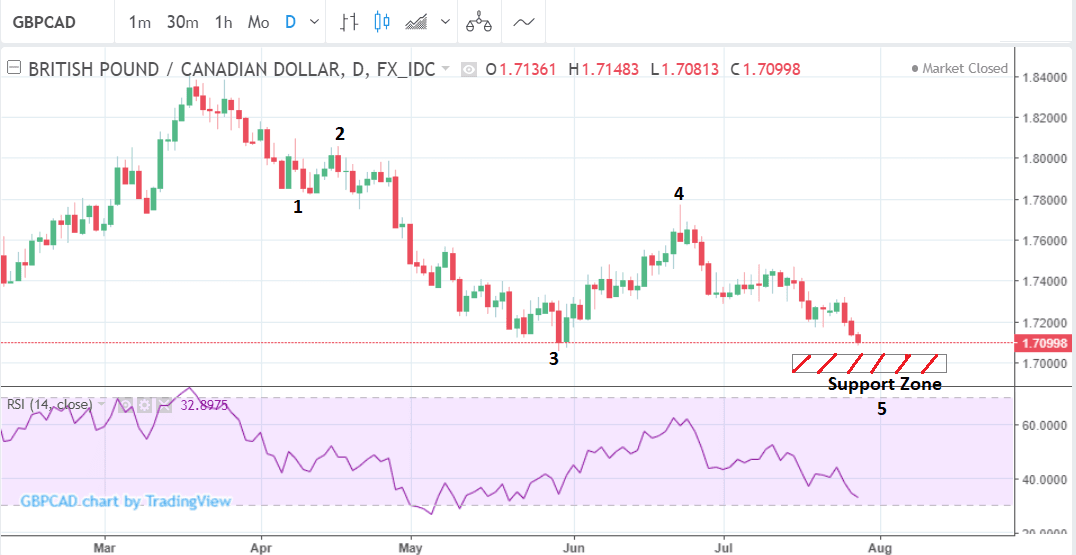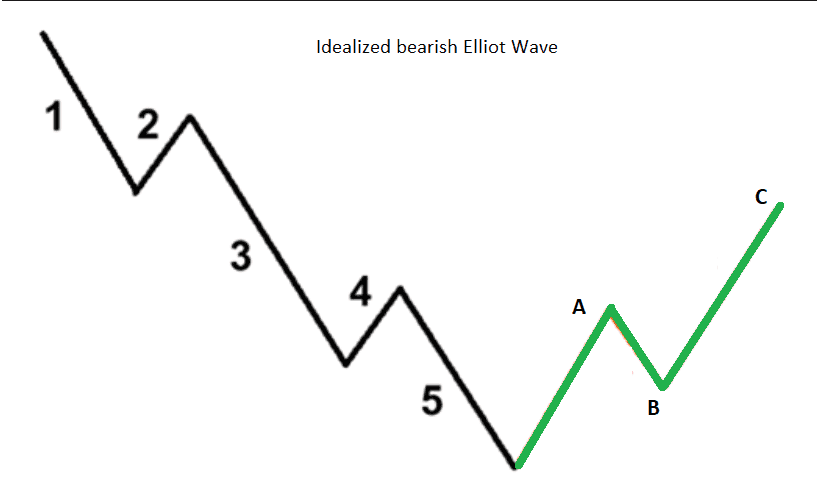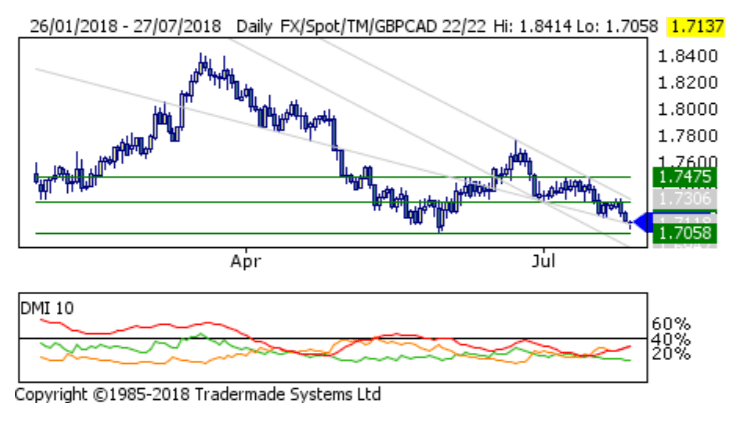The Pound-to-Canadian Dollar Forecast for the Week Ahead: Nearing Support Zone

Image © Pavel Ignatov, Adobe Stock
- GBP/CAD is in a strong downtrend but nearing a support zone
- The bear trend could stall is buyers come in at the May lows
- The main event for Sterling is the Bank of England meeting - for CAD it is GDP growth data
The Canadian Dollar has strengthen versus all G10 currencies and ended the previous week as the strongest of the bunch.
The gains came on the back of an improvement in trade relations between Canada and the US which reduced risks of NAFTA collapsing.
This combined with improving economic data led to increasing chances the Bank of Canada (BOC) will raise interest rates.
NAFTA concerns were a major impediment to the bank hiking rates previously. Higher interest rates are likely to drive up CAD as they attract more inflows of foreign capital.
From a technical perspective, GBP/CAD's downtrend reflects the improving CAD fundamentals sketched above but the pair has also now reached within spitting distance of a major support zone which is likely to prove a tough barrier to further downside, thus we see the chance of momentum slowing in the week ahead as GBP/CAD potentially stalls.
The support zone is made up of the May lows at 1.7055.
Another reason why we think the move down may be close to bottoming is that it is part of a down-cycle which looks as if it is reaching a bottom.
Using Elliot wave analysis, which is a type of cycle analysis, suggests the down move which began at the June highs is probably the wave 5 of a larger wave that began at the March highs.
According to Elliot wave experts, wave 5 usually reaches at least as far as the bottom of wave 3, which in this case is the May lows at 1.7055.
Elliot waves are cycles of buying and selling - of up and down trends - which are composed of 5 waves numbered 1-5, or labeled using Roman numerals, as in I, II, III, IV, and V.
Waves 1,3 and 5 move in the direction of the trend whilst 2 and 4 represent corrections. Wave 3 is almost always the longest and the strongest wave in line with the trend.
After a 5-wave pattern has finished the market corrects back in a shallower counter-trend move labeled A,B, and C.
Not all analysts see the support zone as a major obstacle to more downside, and some see the trend extending even lower.
"At this point, however, we are not persuaded that the GBP sell-off is complete," says Shaun Osborne of Canadian bank Scotiabank, who continues to be bearish the pair.
His reasons are, "firstly, weekly price action remains bearish. Secondly, trend strength studies are aligned bearishly for the GBP across short, medium and longer run DMI studies and this alignment in the DMI signals usually means little or no scope for sustained counter-trend rallies," adds Osborne.
In relation to downside targets, Osborne says the following:
"We had targeted a drop in the GBP to the 1.7000/50 area—which is more or less complete. Loss of support at 1.7055/60 would signal more weakness ahead for the Pound."
Advertisement
Get up to 5% more foreign exchange by using a specialist provider to get closer to the real market rate and avoid the gaping spreads charged by your bank when providing currency. Learn more here
What to Watch For the Canadian Dollar
The main release for the Canadian Dollar in the week ahead is GDP growth data for May, which is forecast to show a rise of 0.3% when it is released at 13.30 B.S.T on Tuesday, July 31, compared to only 0.1% in April.
GDP is expected to show a 2.3% rise compared to the same time in the previous year. This would be lower than the 2.5% year-on-year figure in April.
A greater-than-expected rise would fuel rate hike hopes and propel CAD higher.
Another major release is the trade balance, out on Friday at 13.30, which is forecast to shopw the deficit deepening to -46.1bn from -43.1bn previously. An even lower figure might weigh on CAD as it is a sign a falling demand overall.
Key Events to Watch For Sterling this Week
The main event for Sterling on the economic calendar in the week ahead, is the Bank of England policy meeting on Thursday at 11.00 GMT, followed by governor Carney's press conference at 11.30.
The BOE's quarterly inflation report will also be released at the same time.
The current consensus expectation is for the Bank to announce a rise of 0.25% in the base interest rate in the UK to 0.75%.
A hike will probably result in only limited upside for the Pound as the move is already widely telegraphed and lacks the 'element of surprise' for an explosive thrust higher.
The probability of a hike has been hovering at around circa 80%, supported most recently by last week's positive data releases.
Therefore, what will matter is whether the Bank hints at further interest rate rises in coming months. If the Bank strikes a hawkish tone on the matter then Sterling might well extend higher. If the market gets the sense that this is a 'dovish hike' i.e. one that is unlikely to be followed by another rate rise in coming months then the currency might fall.
"We fear that sterling, which has not benefited so far from prospects of tighter monetary policy at home, may suffer," says UniCredit's Mialich, who adds Sterling is damned if the BoE hikes, damned if it does not."
"If the BoE hikes, as we also expect, we would see this as a policy mistake hurting the economy, and thus the currency, over the medium term. If the bank leaves the rate unchanged, investors’ disappointment will likely lead to new GBP sales," says Mialich.
The one spoiler to a rate hike are Brexit risks.
EU chief negotiator Barnier's recent criticisms of key aspects of the Chequer's plan, such as goods' tracking and variable tariffing, make it possible the BOE could opt for caution and not raise rates at all.
"On data grounds a rate rise would seem justified after the weakness in Q1 proved to be temporary, however the uncertainty seen at the end of July might stay the banks hand," says Michael Hewson, analyst at CMC Markets.
Given the heightened expectations of a hike the shock of a no-change is a major risk for Sterling in the week ahead.
The other main data releases for the Pound are Purchasing Manager Survey Indices (PMIs).
The first PMI to be released is manufacturing out on Wednesday at 9.30 B.S.T, which is forecast to show a slide to 54.2 in July from 54.4 in June, although any result above 50 is indicative of growth.
Construction PMI is out on Thursday at the same time and forecast to show a fall to 52.9 from 53.1.
Services PMI is out on Friday at the same time and is expected to show a fall to 54.7 from 55.1.
PMI's are calculated using the answers from surveys of industry purchasing managers who have a pivotal view of conditions. They are seen as an important leading indicator for the economy and, therefore, impact on Sterling, to which they are positively correlated.
Advertisement
Get up to 5% more foreign exchange by using a specialist provider to get closer to the real market rate and avoid the gaping spreads charged by your bank when providing currency. Learn more here







